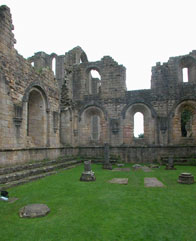 |
 |
 |
 |
 |
 |
 |
|
Fountains Abbey: History
Fountains Abbey: Buildings
|
The chapter meeting (2/3) If you think you’re being dealt with
harshly, you will be soothed if The daily chapter meeting opened with a reading from the martyrology, to commemorate the saints celebrated that day. This was followed by a short morning prayer known as the Pretiosa. A chapter from the Rule of St Benedict was then read out and this marked the real start of proceedings. On Sundays and feast days a passage from either the Cistercian Customs (the Book of Usages) or the Statutes of the General Chapter was read and explained. An office to commemorate the dead concluded the liturgical part of the meeting. Disciplinary matters were then addressed. Each monk was invited to step forward to confess his sins before the community. He prostrated himself on the floor, asked pardon and awaited judgement. Any monk who was not forthcoming was ‘accused’- out of charity - by his brethren, so that he too could be judged, corrected and progress, unhindered, on the road to salvation. Stephen of Sawley, who was a monk and later abbot of Fountains, advised novices to consider this correction as ‘a pittance sent to you from heaven.’ (44)
Punishment usually consisted of fasting, demotion
or beating. Anyone who was to be beaten was punished immediately
in front of his fellow
brethren: the offender’s robe was loosened so that it fell
to his waist and left his flesh exposed, while a member of the
community administered his punishment. The whole community witnessed
these punishments but nobody was to disclose what had transpired
at chapter. In more extreme circumstances, such as murder or sodomy,
the offender might face imprisonment or expulsion. In 1206 the
General Chapter ruled
that prisons might be built within the abbeys for those who offended;
in 1230 it was stipulated that these should
be strong and secure. Statutes issued by the General
Chapter suggest
that from the second half of the thirteenth century, life imprisonment
was not uncommon.(45) |
